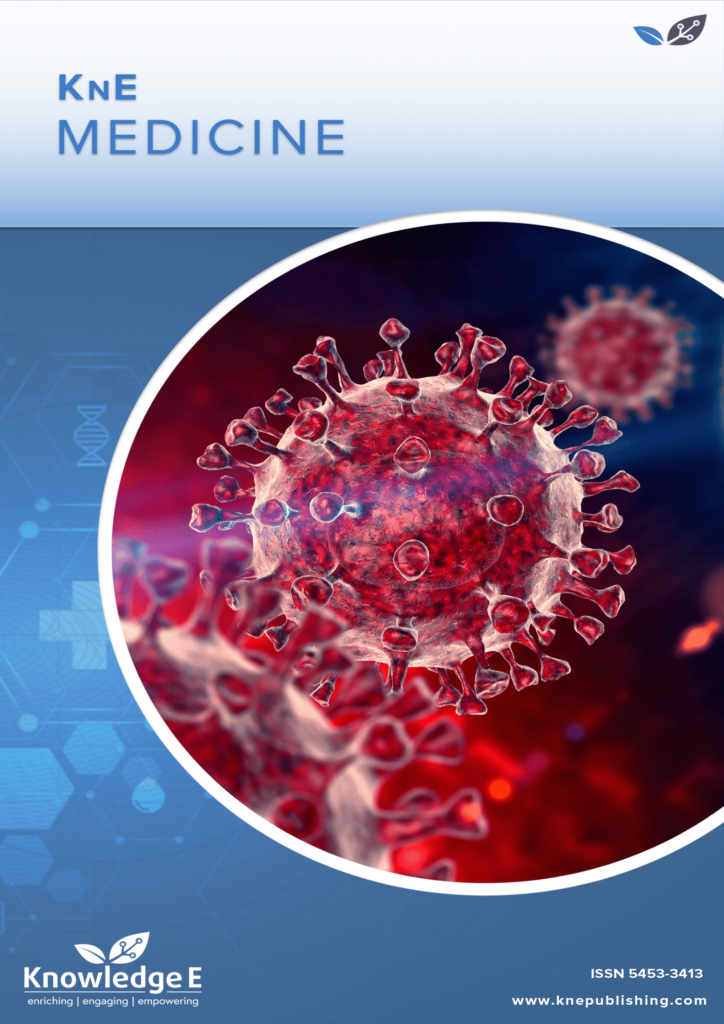
KnE Medicine
ISSN: 2519-125X
The latest conference proceedings on all fields of medicine.
Comparison of Vitamin C Analysis Using High-Performance Liquid Chromatography Versus Potentiometric Titration
Published date: Sep 15 2022
Journal Title: KnE Medicine
Issue title: The International Conference of Medicine and Health (ICMEDH)
Pages: 393–404
Authors:
Abstract:
Vitamin C is a water-soluble vitamin that is important for human health as it helps to maintain the body’s resistance to various diseases. It functions as an antioxidant, which is a substance that gives electrons to free radicals and helps to stabilize free radicals, which protects cells from damage. Because vitamin C is easily oxidized, an analytical method is needed which measures vitamin C levels accurately and quickly. Analytical methods must be validated before being implemented to ensure the validity of the data generated. In this study, the validation of two vitamin C measurement methods were be compared: high-performance liquid chromatography (HPLC) and potentiometric titration. The results of the HPLC method showed that the linearity, accuracy, and precision met the validation requirements of the official methods of analysis (AOAC). The potentiometric titration method validation results showed that the accuracy met the AOAC requirements while the precision did not meet the AOAC requirements.
Keywords: validation, HPLC, potentiometric titration, vitamin C
References:
[1] A. Labellapansa, “Defisiensi Vitamin dan Mineral.,” Informatika. vol. 10, p. 2016.
[2] S.H. Mitmesser, Q. Ye, M. Evans, and M. Combs, “Determination of plasma and leukocyte vitamin C concentrations in a randomized, double-blind, placebocontrolled trial with Ester-C®.,” SpringerPlus. vol. 5, no. 1, pp. 1–11, 2016.
[3] M.A. Moser and O.K. Chun, “Vitamin C and heart health: a review based on findings from epidemiologic studies.,” International journal of molecular sciences. vol. 17, no. 8, p. 1328, 2016.
[4] Williams and Wilkins, Ilmu Gizi Menjadi Sangat Mudah Edisi Kedua., 2011.
[5] A.M. Preston, C. Rodriguez, C.E. Rivera, and H. Sahai, “Influence of environmental tobacco smoke on vitamin C status in children.,” The American journal of clinical nutrition. vol. 77, no. 1, pp. 167–172, 2003.
[6] J.D. Cook and M.B. Reddy, “Effect of ascorbic acid intake on nonheme-iron absorption from a complete diet.,” The American journal of clinical nutrition. vol. 73, no. 1, pp. 93–98, 2001.
[7] L.K. Massey, M. Liebman, and S.A. Kynast-Gales, “Ascorbate increases human oxaluria and kidney stone risk.,” The Journal of nutrition. vol. 135, no. 7, pp. 1673– 1677, 2005.
[8] S. Ullah, A. Hussain, J. Ali, and A. Ullah, “A simple and rapid HPLC method for analysis of vitamin-C in local packed juices of Pakistan.,” Middle East Journal of Scientific Research. vol. 12, no. 8, pp. 1085–1091, 2012.
[9] Ph. D Riyanto, Validasi & Verifikasi Metode Uji: Sesuai dengan ISO/IEC 17025 Laboratorium Pengujian dan Kalibrasi., 2014.
[10] Harmita, Petunjuk pelaksanaan validasi metode dan Cara Perhitungannya., 2004.
[11] S. Watanabe, “[Drug information for safe use].,” Yakugaku zasshi : Journal of the Pharmaceutical Society of Japan. vol. 134, no. 3, pp. 351–353, 2014.
[12] V. Spínola, B. Mendes, J.S. Câmara, and P.C. Castilho, “Effect of time and temperature on vitamin C stability in horticultural extracts. UHPLC-PDA vs iodometric titration as analytical methods.,” LWT-Food Science and Technology. vol. 50, no. 2, pp. 489– 495, 2013.
[13] A. Requirements, “Alpha Lipoic Acid Tablets.,” no. c, pp. 2011–2012, 2012.
[14] J.J. Wright, E. Salvadori, H.R. Bridges, J. Hirst, and M.M. Roessler, “Small-volume potentiometric titrations: EPR investigations of Fe-S cluster N2 in mitochondrial complex I.,” Journal of inorganic biochemistry. vol. 162, pp. 201–206, 2016.
[15] Suyanta, Potensiometri., 2013.
[16] I.G. Gandjar and A. Rohman, “Kimia farmasi analisis.,” Yogyakarta: Pustaka Pelajar. vol. 224, p. 228, 2007.
[17] H. Harmita, “Petunjuk pelaksanaan validasi metode dan Cara Perhitungannya.,” Majalah Ilmu Kefarmasian. vol. 1, no. 3, p. 1, 2004.
[18] W. Horwitz, “AOAC guidelines for single laboratory validation of chemical methods for dietary supplements and botanicals.,” Gaithersburg, MD, USA: AOAC International. pp. 12–19, 2002.